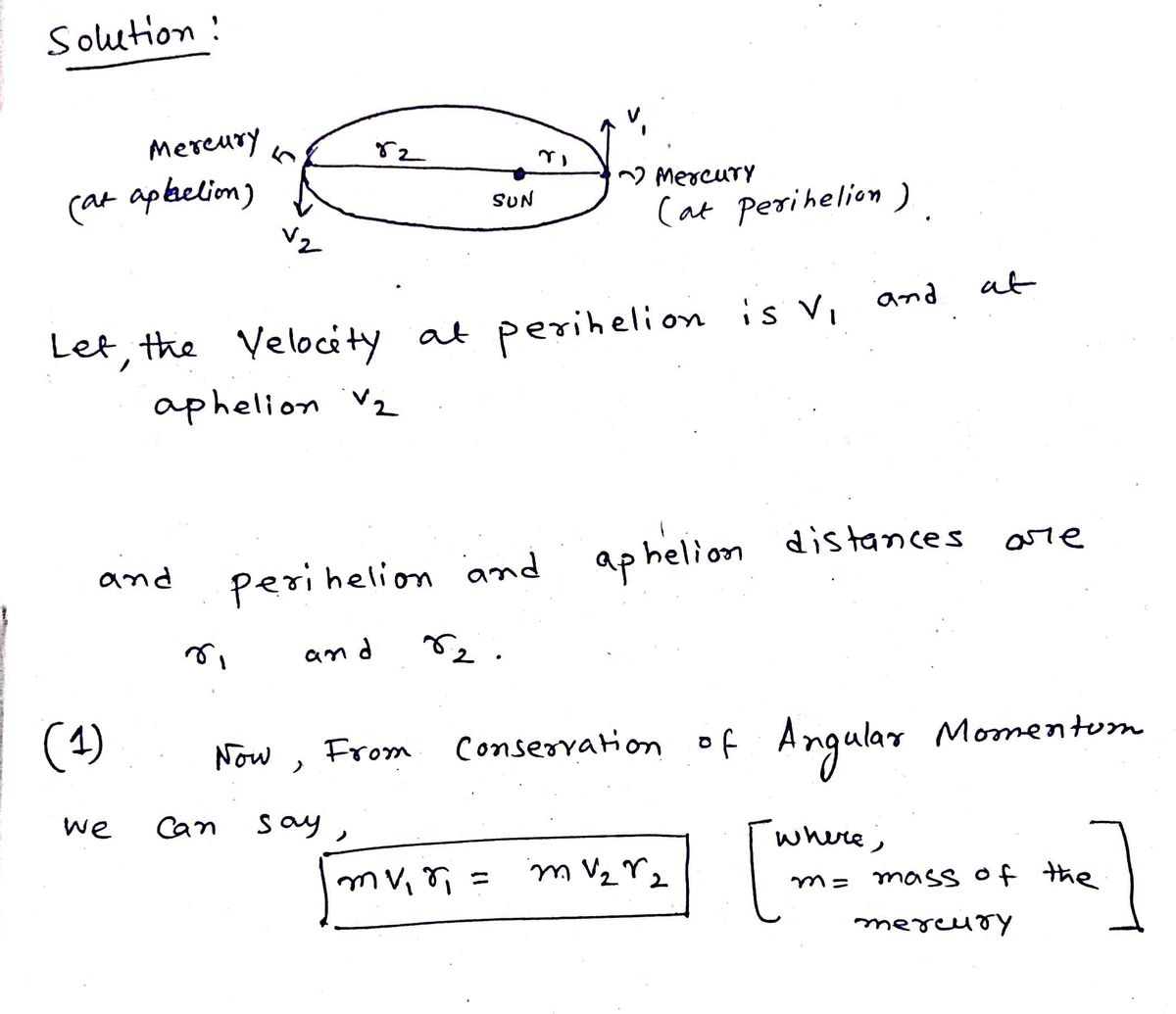2. (This is a problem from Physics 211 (Mechanics). Of course it has an electrical analog in the hydrogen atom, due to the analogy between gravity and electricity.) You are to make use of Kepler's laws of planetary motion to solve this problem. The orbit of Mercury around the sun is actually an ellipse with a very small eccentricity. For elliptical motion the location of the distance of closest approach of a planet to the sun is called the perihelion, and the location of the furthest distance of planet from the sun is called the aphelion. You are given the following data: mass of the sun: 1.98 × 10³0 kg; distance of Mercury from the sun at the perihelion: 24 X 100 km; speed of Mercury at the perihelion: 50 km/sec; speed of Mercury at the aphelion: 34 km/ sec; G = 6.67 X 10-¹1 m³/(kg sec²). Determine: 1) the distance of Mercury from the sun when it is located at the aphelion; 2) the length of a Mercurian year in seconds.
2. (This is a problem from Physics 211 (Mechanics). Of course it has an electrical analog in the hydrogen atom, due to the analogy between gravity and electricity.) You are to make use of Kepler's laws of planetary motion to solve this problem. The orbit of Mercury around the sun is actually an ellipse with a very small eccentricity. For elliptical motion the location of the distance of closest approach of a planet to the sun is called the perihelion, and the location of the furthest distance of planet from the sun is called the aphelion. You are given the following data: mass of the sun: 1.98 × 10³0 kg; distance of Mercury from the sun at the perihelion: 24 X 100 km; speed of Mercury at the perihelion: 50 km/sec; speed of Mercury at the aphelion: 34 km/ sec; G = 6.67 X 10-¹1 m³/(kg sec²). Determine: 1) the distance of Mercury from the sun when it is located at the aphelion; 2) the length of a Mercurian year in seconds.
College Physics
11th Edition
ISBN:9781305952300
Author:Raymond A. Serway, Chris Vuille
Publisher:Raymond A. Serway, Chris Vuille
Chapter1: Units, Trigonometry. And Vectors
Section: Chapter Questions
Problem 1CQ: Estimate the order of magnitude of the length, in meters, of each of the following; (a) a mouse, (b)...
Related questions
Question
100%
Chapter 21 and 22, Problem 2

Transcribed Image Text:2. (This is a problem from Physics 211 (Mechanics). Of course it has an electrical analog in the
hydrogen atom, due to the analogy between gravity and electricity.) You are to make use of Kepler's laws
of planetary motion to solve this problem. The orbit of Mercury around the sun is actually an ellipse with
a very small eccentricity. For elliptical motion the location of the distance of closest approach of a planet
to the sun is called the perihelion, and the location of the furthest distance of planet from the sun is called
the aphelion. You are given the following data: mass of the sun: 1.98 × 1030 kg; distance of Mercury
from the sun at the perihelion: 24 X 100 km; speed of Mercury at the perihelion: 50 km/sec; speed of
Mercury at the aphelion: 34 km/ sec; G = 6.67 x 10-¹1 m³/(kg sec2). Determine: 1) the distance of
Mercury from the sun when it is located at the aphelion; 2) the length of a Mercurian year in seconds.
6
Expert Solution
Step 1

Step by step
Solved in 2 steps with 2 images

Knowledge Booster
Learn more about
Need a deep-dive on the concept behind this application? Look no further. Learn more about this topic, physics and related others by exploring similar questions and additional content below.Recommended textbooks for you

College Physics
Physics
ISBN:
9781305952300
Author:
Raymond A. Serway, Chris Vuille
Publisher:
Cengage Learning

University Physics (14th Edition)
Physics
ISBN:
9780133969290
Author:
Hugh D. Young, Roger A. Freedman
Publisher:
PEARSON

Introduction To Quantum Mechanics
Physics
ISBN:
9781107189638
Author:
Griffiths, David J., Schroeter, Darrell F.
Publisher:
Cambridge University Press

College Physics
Physics
ISBN:
9781305952300
Author:
Raymond A. Serway, Chris Vuille
Publisher:
Cengage Learning

University Physics (14th Edition)
Physics
ISBN:
9780133969290
Author:
Hugh D. Young, Roger A. Freedman
Publisher:
PEARSON

Introduction To Quantum Mechanics
Physics
ISBN:
9781107189638
Author:
Griffiths, David J., Schroeter, Darrell F.
Publisher:
Cambridge University Press

Physics for Scientists and Engineers
Physics
ISBN:
9781337553278
Author:
Raymond A. Serway, John W. Jewett
Publisher:
Cengage Learning

Lecture- Tutorials for Introductory Astronomy
Physics
ISBN:
9780321820464
Author:
Edward E. Prather, Tim P. Slater, Jeff P. Adams, Gina Brissenden
Publisher:
Addison-Wesley

College Physics: A Strategic Approach (4th Editio…
Physics
ISBN:
9780134609034
Author:
Randall D. Knight (Professor Emeritus), Brian Jones, Stuart Field
Publisher:
PEARSON